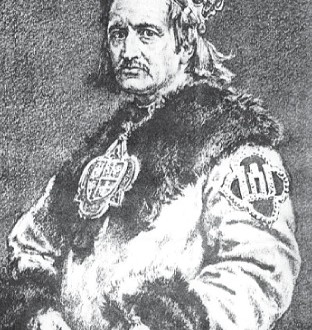BY EDVARDAS BARANAUSKAS

IT IS INTERESTING TO NOTE HOW Jogaila (1350–1434), the ruler of the Grand Duchy of Lithuania, became involved with the Polish royal family, and his eventual marriage to their young queen. Very little is mentioned by historians that he was widowed three times, that his fourth marriage resulted in his becoming a father at the age of 72, or that his grandson was Saint Casimir, the patron saint of Lithuania.
Jogaila probably never realized that his marriage to the Polish queen in 1386 would change the course of history of both Lithuania and Poland.
The king of Poland at that time was also the king of Hungary—Louis d’Anjou. He arranged that after his death, Jadvyga (Poles call her Jadwiga, while other historians know her as Hedwig), his younger daughter, should occupy the throne of Hungary; and Mary, his older daughter, would take the throne of Poland. Jadvyga had been betrothed to William of Austria at the age of four, and upon her coming to age, Hungary and Austria would be united. Mary was betrothed to a Bohemian prince, Sigismund of Luxembourg, which would join Bohemia and Poland.
Jadvyga (c.1374 – 1399)
When Louis died in 1382, the Polish magnates rejected Mary to be their queen. Because of all the troubles Poland had had with Bohemia in the past, they did not want any Bohemian connection. Louis’ widow, Elizabeth, then sent Jadvyga to Poland to take Mary’s place.
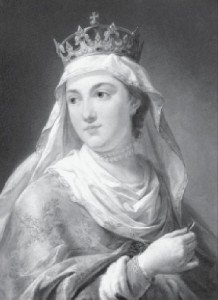
This also presented a problem for the nobles of Poland.
Jadvyga was promised to William of Austria, a Habsburg, and if everything went according to this prearranged plan, they would someday marry. This did not please the Polish lords for they did not want the future king of Poland to be of Germanic descent. A series of meetings throughout early 1383 took place. Finally, the Polish nobles accepted Jadvyga, in the interest of keeping the kingdom together, provided that she break her betrothal to William.
The Polish nobles now turned their attention to Lithuania, a country three times larger than Poland, and who also shared the same enemy, the Teutonic Order.
The Poles offered Jogaila a deal. They wanted him to accept the Roman Catholic faith, to marry their queen, and to become king of Poland. These negotiations were going on even before Jadvyga was crowned King of Poland in Krakow on October 15, 1384 at the age of eleven. (Although Jadvyga is usually called Queen of Poland, her official title was King of Poland. The masculine gender in her title was intended to underline the fact that she was a monarch in her own right, not a queen consort.)
Poland and Lithuania decided that the marriage of Jadvyga and Jogaila would benefit both countries.
The Polish magnates wanted to end Poland’s undesirable union with Hungary. They wanted a king who was not from the Habsburg family, which was becoming so powerful in Central Europe that they feared it might someday threaten Poland’s political independence. And they also wanted an ally against threats from the Teutonic Knights, and a chance to convert the pagan Lithuanians to Christianity.
Jogaila was engaged in a bitter struggle for the rule of Lithuania with his cousin Vytautas. He felt that if he turned to Poland, his position would be more secure as Grand Duke of Lithuania. Also, the question of Lithuania’s acceptance of Christianity would finally be resolved. He was also in search of an ally during conflicts with the Teutonic Knights and Muscovy, wanted to reduce the influence of the Orthodox Russians in his territory, and hoped to strengthen his position in the West.
Jadvyga was reluctant to break her engagement to William and marry a pagan who was three times her age. The Polish Council of Lords convinced her that this marriage was in the best interests of Poland, and stressed its importance to the cause of Christianity.
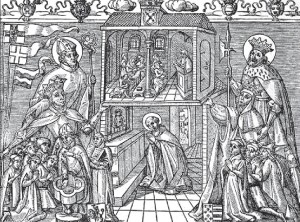
Preparing to sign an agreement with Poland, Jogaila made peace with Vytautas. A delegation from Poland arrived at the castle of Kriavas (also called Krėva), an important Lithuanian political center once ruled by Algirdas, Jogaila’s father. Today Kriavas is in Belarus, not far from the present Lithuanian border.
The agreement between the two countries, made on August 15, 1385, became known as the “Act of Kriavas.” It was signed by Jogaila in the presence of a number of Lithuanian nobles and Polish delegates. Jogaila agreed to be baptized and to accept Christianity for the entire Lithuanian nation. He also agreed to recover lands that Poland had lost. In addition, he would pay 200,000 Austrian florins to William as compensation for breaking the engagement to Jadvyga. Jogaila would unite the Grand Duchy of Lithuania with the Kingdom of Poland under his rule.
The wording of the Treaty of Kriavas is vague. It is unclear if the union of the two countries was permanent, or if it could be revoked by Lithuania. Some historians say Jogaila intentionally made the wording vague, because throughout his life he was known to try to keep as many options open as possible.
Jogaila arrived in Krakow, which was Poland’s capital at the time, with his brothers and cousin Vytautas on February 14, 1386. The next day he was baptized and given the Christian name Wladyslaw (Lithuanian Vladislovas).
Jogaila and Jadvyga were married on February 18, 1386. He was 36 years of age while she was a young teenager of 12. On March 4, Jogaila was crowned king of Poland as Wladyslaw II Jagiello. He settled in Poland, leaving the rule of Lithuania to his cousin Vytautas the Great.
The royal couple had no children for thirteen years. On June 22, 1399, Jadvyga gave birth to a daughter, Elizabeth Bonifacia, but she and the baby died within a month due to birth complications. They were buried together, side by side in the same coffin, at Krakow’s Wawel Cathedral.
During his visit to Poland in 1979, the late Pope John Paul II beatified Queen Jadvyga. He canonized her as a saint of the Catholic Church in Krakow on June 8, 1997.
Anna (1380 – 1416)
The deaths of both the queen and her only child stunned the nation. The line of succession of the Polish crown was now broken. Jogaila expressed a desire to return to his native Lithuania, and this alarmed the Polish nobles because they wanted to maintain their friendship and union with the Grand Duchy. They had the power to elect a new king if he left, but they hoped it would not come to that. To convince Jogaila they wanted him to remain as their king, the Polish lords declared their support and loyalty to him. Vytautas used his influence to convince Jogaila not to resign, for political reasons of his own. He knew that if Jogaila returned to Lithuania, he would not have much of a chance to remain as Grand Duke.
It had been said that Jadvyga, on her deathbed, urged Jogaila to remarry, and recommended as his spouse Anna, Countess of Cilli, the granddaughter of King Casimir the Great. Anna lived in Austria, and apparently Jadvyga did not know that she had married a German prince.
The Polish lords then chose her daughter, also named Anna. The nineteen-year-old Anna Cilli arrived in Krakow on July 16, 1401.
Jogaila was somewhat disappointed with his future bride, for she was not a beautiful woman. Being raised in a German-speaking environment, she presented another problem—she could only speak German.
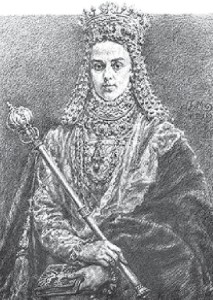
Anna should not have felt too badly, for, according to historians, many of the Polish dignitaries of that time could not read or write very well, and this was also true for the rest of Europe. Pope Boniface IX, for example, was able to read, but never mastered the art of writing. Jogaila had his own problems, too, when he began to govern Poland. He never became fluent in Polish.
While Anna was taking lessons to learn Polish, Jogaila spent his time in Lithuania. He returned to Krakow in time for the wedding, which took place on January 29, 1402, and a week later, Anna was crowned queen of Poland.
Six years later, a daughter was born and was given the name of Jadvyga.
Jogaila and Anna were married for fourteen years. She died on March 21, 1416 at the age of 35 and was buried in Krakow. Jogaila was now widowed again, at the age of 66.
Elizabeth (1348 – 1419)
A year after he mourned the passing of his second wife, Jogaila began to make plans for marrying again. He found the woman who was to become his third wife where he never thought he would.
After a hunting trip to Lithuania in 1417, he went to visit his favorite sister, Aleksandra Algirdaitė, who lived on an estate with her husband, the Duke of Mazovia. It was there that he met her good friend, the widow Elizabeth Granovski, daughter of Count Otto of Pilcza. She was a beautiful woman, and she impressed Jogaila very much. It was then that he decided to marry her. The first discussions began with his sister as intermediary, and marriage plans were agreed upon, despite the objections of the Polish magnates.
Elizabeth was born around 1348 to parents who were wealthy nobles. She was the only child, and became one of the richest women in Poland after they passed away.
Elizabeth was widowed three times, according to some historians. Her third husband was a quiet man, Vincent Granovski, who had married her in 1400, and they had one son and two daughters. He died around 1410. The historian Kantecki claimed that the story of her having three husbands was only a legend, and proved that she only had but one husband—Granovski.
Because of opposition by the Polish nobles, the wedding did not take place in Krakow, but in the part of Poland known as Red Ruthenia, on May 2, 1417. Jogaila returned with his bride after traveling around the Eastern lands, and the people of Krakow greeted them with honors.
But the Polish magnates refused to have Elizabeth crowned queen. They reminded Jogaila that there could not be two queens, since in 1413 they had given Jadvyga, his daughter by his second wife, an oath that she was the heiress to the throne. They told him that nobody would recognize Elizabeth as queen. Jogaila declared that whether they liked it or not, he would still have his wife crowned. Seeing that they were unable to come to an agreement in a nice way, Jogaila again threatened to return to Lithuania. The nobles feared that if he did, it would be the end of the PolishLithuanian union and would result in political turmoil in both countries. The magnates softened their hardline position, and Jogaila won. Elizabeth was crowned queen of Poland at Krakow’s Wawel Cathedral.
One of the reasons why Elizabeth didn’t endear herself to many Polish nobles was because she wanted to make peace with the Teutonic Order, Poland’s mortal enemy. She was in a position to influence her husband’s policies, and encouraged him not to let the magnates gain the upper hand over him. Elizabeth was an educated woman, and would make sure the royal secretary would write what Jogaila wanted, not what he wanted.
It was believed that Jogaila married Elizabeth because of her beauty. At the time, he was 67 years old, and she was about 37, or possibly a little older. They were married only two years, and had no children. She died on May 12, 1419.
Sophia (1405 – 1461)
The death of Jogaila’s third wife, Elizabeth, resulted in another confrontation between him and the Polish nobles. They had decided, several years before, that his daughter Jadvyga would be his successor, and were looking for an acceptable husband for her. They were unyielding in their position, but Jogaila had other plans.
His decision upset the Polish lords, and changed the course of history. Vytautas persuaded Jogaila to marry the Lithuanian princess Sonka, daughter of Kiev’s Prince Andrew (Andrius). She was the niece of Vytautas’ second wife, Julianna. Sonka was of the Orthodox faith because it was the tradition that Lithuanian princes who ruled Slavic lands should take the people’s beliefs. When Sonka converted to Catholicism, she took the name of Sophia.
The nobles were adamant in their opposition because they feared that Lithuania’s influence in Krakow would strengthen too much. But Jogaila was not discouraged. He and Sophia went to Naugardukas, a town in Lithuania, but which today is in Belarus, and were married there on February 7, 1422 in great splendor. Jogaila was already 70, and Sophie about 17.
The coronation ceremony was delayed for two years before the Polish lords finally gave their consent. Sophia was crowned queen of Poland on February 12, 1424, and later that year, she gave birth to their first child, a son named Wladyslaw, his father’s baptismal name. A few years later, a second son was born, named Casimir, but he died while an infant. On November 30, 1427, their third son was born, and was also named Casimir. He was of perfect health, and bore a striking resemblance to his father, who was then 75.
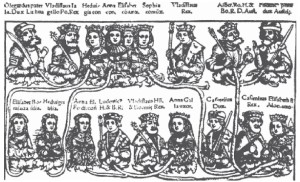
The family’s success astounded many, and people began to gossip that Sophia was not faithful to her husband. To end these rumors, she swore before the bishop of Krakow that she was innocent, and that these accusations were false. Sophia was vindicated. It was believed these charges were made against her on political grounds in order to deny the legitimacy of Jogaila’s sons, thus nullifying his hopes for a dynasty.
The birth of a son was a blessing for Jogaila. The lords agreed to recognize him as heir to the throne. When Jogaila died in 1434 at the age of 84, his oldest son succeeded him as Wladislaw III at the age of 10. And his youngest son, Casimir, was elected by the magnates of Lithuania in 1440 as the sovereign Grand Duke of Lithuania. The traditional coronation ceremonies took place at Vilnius Cathedral.
Wladyslaw III died in battle against the Turks in 1444. Casimir was next in line of succession, but three years went by before the Lithuanians and Poles settled their differences about Casimir. In June 1447 he was crowned in Krakow as Casimir IV, King of Poland. Now he ruled both Poland and Lithuania, as his father did.
Casimir married Elizabeth of Austria in 1454. They had thirteen children, of whom two died as infants. Six were sons. Their third child, and second son, was also named Casimir, and it was he who eventually became Saint Casimir, the patron saint of Lithuania.
Jadvyga, Jogaila’s daughter from his second marriage, never married and died in 1431 at the age of 23. She was considered by the Polish nobility as the true heiress to the throne at one time, but Jogaila’s fourth marriage and birth of two sons changed everything.
Sophia, Jogaila’s fourth wife, died in Krakow in 1461 at the age of 56 and was regarded by historians as one of the outstanding female sovereigns of her era. Two Lithuanians, Jogaila and Sophia, changed the course of history of both Poland and Lithuania.
Jogaila ruled Poland for 48 years and was the longest reigning monarch in its history. Polish historians regard his tenure on the throne as the beginning of the Jagiellonian Dynasty, the “Golden Age,” or the “Golden Centuries” of Polish history. Lithuanian historians, on the other hand, regard that period as the continuation of the Gediminian Dynasty, begun by Jogaila’s grandfather Gediminas in the 14th century. The dynasty ended in 1572 when the last male member of the dynasty, King Sigismund August, died without leaving a heir.
Sources:
Jogaila, A. Šapoka, Kaunas, 1935.
Jagiellonian Poland, Pawel Jusienica.
Jadwiga of Anjou and the Rise of East Central Europe, Oscar Halecki.
Encyclopedia Lituanica, Vol. V, p. 256.
 DRAUGAS NEWS Lithuanian World Wide News in English
DRAUGAS NEWS Lithuanian World Wide News in English
